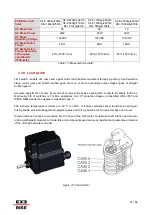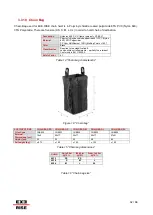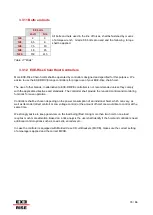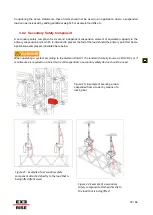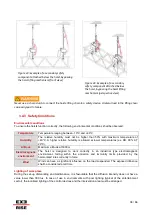
21 / 66
Class
1Bm
1Am
2m
3m
Duty factor of motor
25%
30%
40%
50%
Starts per hour
150
180
240
300
Table 6 “FEM Classification”
Depending on its operating hours and the load applied the same hoist can also be used in another duty
class. Please contact LITEC Italia for support if this is required.
Table 7
gives guidance for correct selection
Load spectrum
Average operating time per day in hours
≤0.25
≤0.5
≤1
≤2
≤4
≤8
≤16
Light
1Bm
1Am
2m
3m
Moderate
1Bm
1Am
2m
3m
Heavy
1Bm
1Am
2m
3m
Very Heavy
1Bm
1Am
2m
3m
Table 7 “Average operating time per day in hours”
Direct control hoists
The terms direct control (DC) and low-voltage controlled (LVC) refer to the system used to manage hoist
movement, not to the power supply voltage.
With DC hoists, the travel direction is determined directly by the phase sequence of the three phase power
supplied to the red CEE plug fitted (CEE 16A 6h 400 VAC
– 3PH). Phase reversing contactors are inside the
controller and not inside the hoist. The hoist lifts when the three power phases are in normal sequence and
lowers when they are inverted.
DC hoists have an integrated mechanical emergency overload device known as the slip clutch. This slip
clutch is adjustable but changes to this device must only be performed by an officially trained and competent
person. A chain stop (a two part metal block) is attached to the end of the load chain, 11 links form the end,
which prevents the chain from running through the hoist should it overrun the length of the chain.
The chain stop shall be placed 11 links from the end. This gives the user or person carrying out any
inspection, access an unloaded length of chain as measuring reference compared to rest of the chain which
will have been under load.
Low Voltage Controlled hoist
LVC hoists are fitted with a CEE plug (CEE 16A 6h 400 VAC
– 3PH) for three phase power and a yellow
CEE plug (CEE 16A 4h 24 VAC
– 3PH) for control purposes. The direction signal is given by a low voltage
hoist controller and is transmitted along the control cable which activates reversing contactors inside the
hoist body.
LVC hoists have an integrated mechanical emergency overload device known as the slip clutch. This slip
clutch is adjustable but changes to this device must only be performed by an officially trained and competent
person.

























